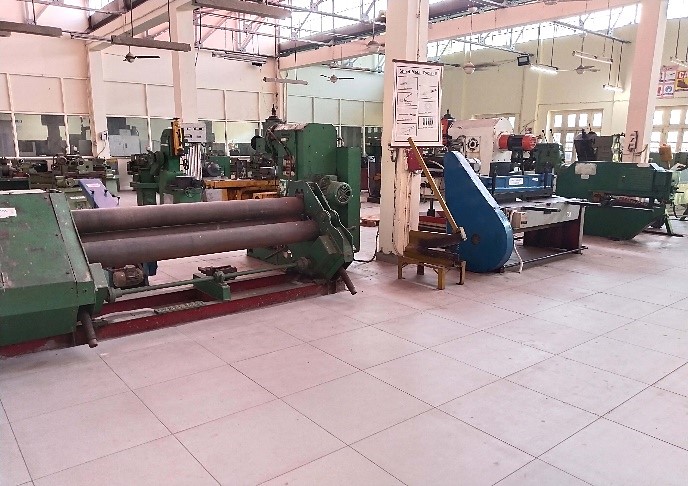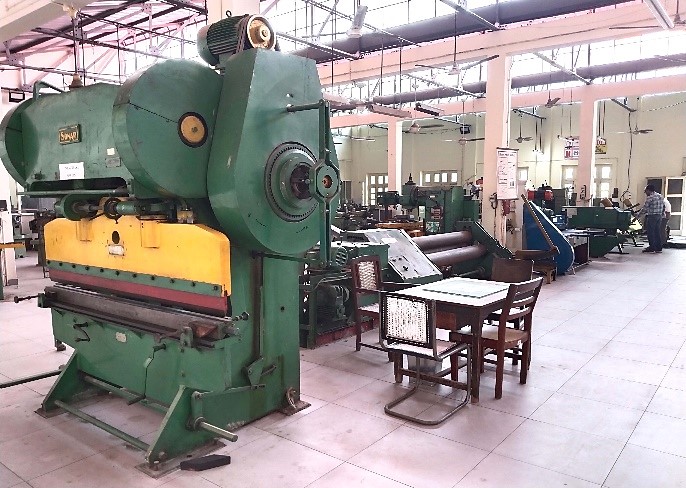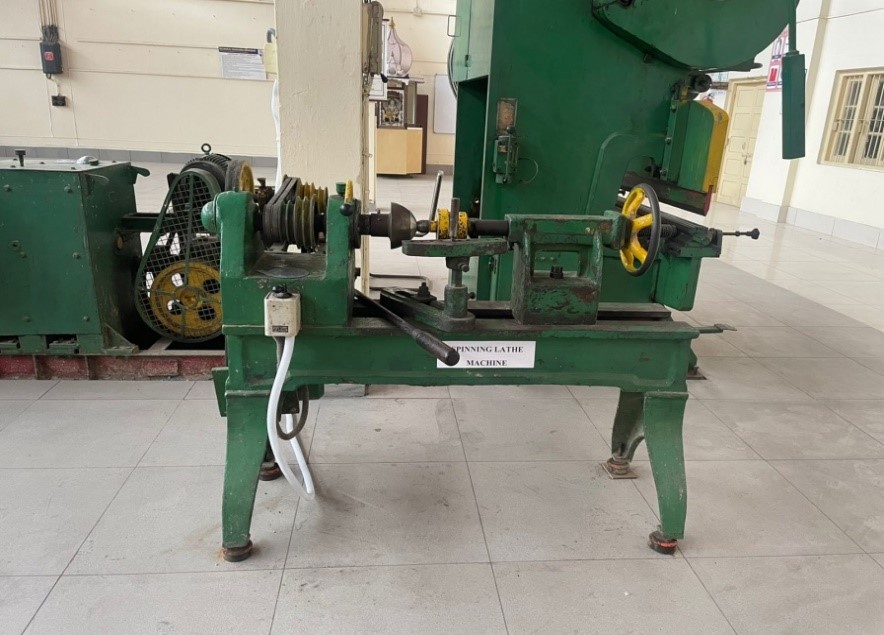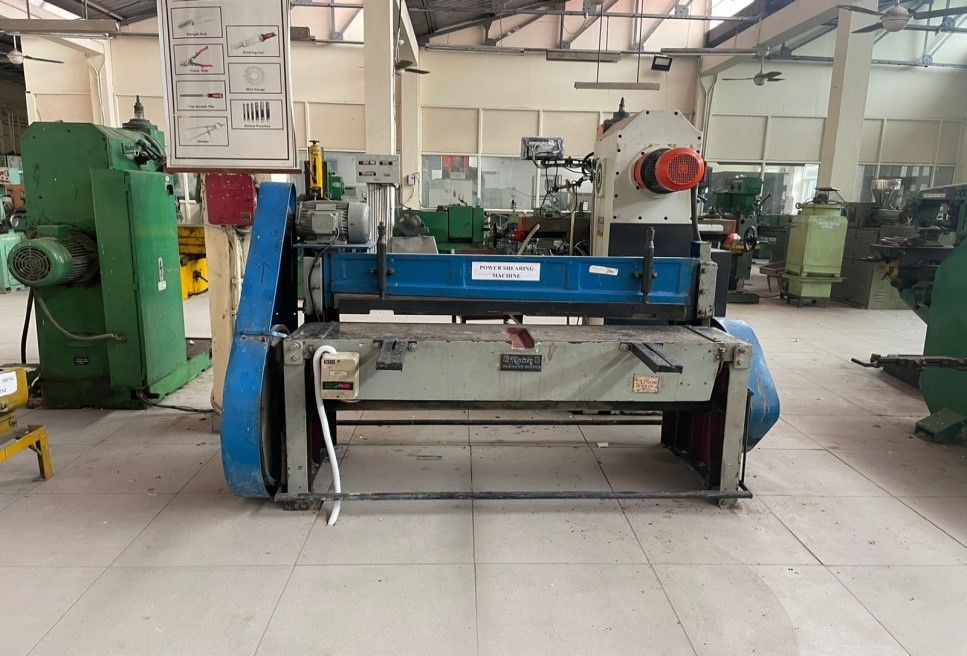



STAFF:
List of Machinery:
|
Make |
Machine Tool Traders, Madras, India |
|
Model |
SL-22 |
|
Title of the related experiment: |
Sheet metal fabrication techniques |
|
A brief explanation of the usage of the said equipment |
The spinning lathe machine is a type of lathe machine used to shape a workpiece by causing the metal to “flow” into a predetermined shape. This machine can be used for MS sheets of Up to 22 gauge. This process is frequently used to create rounded metal parts and products, ranging from aerospace components to decorative household goods. Metal spinning centres around a metal workpiece, or blank, held between a rotating mandrel and a spindle tool. As a mechanism rotates these components, spinning rollers are pressed against the workpiece using manual control. The workpiece is then positioned against the mandrel, which shapes the metal into an intended design through a sequence of axial strokes delivered via rotation. Metal spinning does not involve the removal of material, as in conventional wood or metal turning, but forming (molding) of sheet metal over an existing shape. With this machine, students should be able to: · Make parts that are symmetrical and have a circular cross-section
|
2.Press Brake Machine
|
Make |
SONAR RAJKOT |
|
Model |
PB-1800 |
|
Title of the related experiment: |
Sheet metal fabrication techniques, |
|
A brief explanation of the usage of the said equipment |
A press brake machine is a pressing tool for bending sheet and plate material. This machine is used to bend the sheet up to a thickness of 6 mm. It forms predetermined bends by clamping the workpiece between a matching punch and die. A brake can be described by basic parameters, such as the force or tonnage and the working length. Additional parameters include the stroke length, the distance between the frame uprights or side housings, the distance to the back gauge, and work height. In a mechanical press, energy is added to a flywheel with an electric motor. A clutch engages the flywheel to power a crank mechanism that moves the ram vertically. Accuracy and speed are two advantages of the mechanical press. With this machine, students should be able to: · bend sheet metal and a handful of other materials |
3.Plate Bending/Rolling
|
Make |
PARKASH FEBRICATOR, KOHLAPUR |
|
Model |
PB-72 |
|
Title of the related experiment: |
Sheet metal fabrication techniques, |
|
A brief explanation of the usage of the said equipment |
The rolling machine consists of three rollers used for rolling/bending sheets. It is manufacturing equipment that contains two or more rollers through which the metal plate is fed. The purpose of rolling machines is to compress the metal into a thinner and more uniform shape and continuously bend plates, with the function of rolling O-type, U-shaped, multi-segment R and other forms of the plate. This machine can be used for rolling/bending sheets with thicknesses up to 12 mm. The rollers freely rotate about three parallel axes, which are arranged with uniform horizontal spacing. Two outer rollers, usually immobile, cradle the bottom of the material while the inner roller, whose position is adjustable, presses on the topside of the material. With this machine, students should be able to · Bend the same sheet with different bend ratios
|
4.Power Shearing Machine
|
Make |
KABIR LUDHIANA |
|
Model |
PS-16 |
|
Title of the related experiment: |
Sheet metal fabrication techniques, |
|
A Brief explanation of the usage of the said equipment |
The power shearing machine consists of two blades. It uses a moving upper blade and a fixed lower blade to apply shearing force to metal sheets of various thicknesses by using a reasonable blade gap to make the sheets break and separate according to the required size. This machine is used for sheets up to 16 inches and can perform a shearing operation up to 3mm thick. With this machine, students will be able to · Use it for cutting alloys and other sheet metals.
|
5.Universal Nibbling Machine
|
Make |
Ashok Manufacturing Company India |
|
Model |
Universal Nibbling Machine |
|
Title of the related experiment: |
Sheet metal fabrication techniques, |
|
A brief explanation of the usage of the said equipment |
The universal nibbling machine is used to cut the sheet between the fast reciprocating motion of the upper tool (powered by an electric motor and driven by an eccentric crank) and a stationary lower tool, by progressive punching as the sheet is fed. This machine can perform shearing Up to a thickness of 2.5mm. The upper and bottom tools are changed in the operation of beading, folding, flanging and punching. The length of the tool stroke is easily adjusted on variable steps. Nibbling describes a separating production process which means the workpiece is cut off in stages using a cutting punch. Nibbling machines are used in machining to produce individual cutouts in the shape and size required. Using this process, students will be able to · To produce individual cutouts of different shapes and sizes in sheets. |
6.Sheet Bending Machine
|
Make |
Bharat Transformer Corp. India |
|
Model |
SB-1800 |
|
Title of the related experiment: |
Sheet metal fabrication techniques, |
|
A brief explanation of the usage of the said equipment |
It is used for bending and straightening metal sheets and strips. Sheet-bending machines with rotary bending beams are designed for cold linear bending to produce parts of various shapes. This machine can bend sheets up to a thickness of 1.5mm. Metals must be bent into different shapes and sizes for various industry applications. They are usually tough and cannot be bent or shaped easily. This sheet-bending machine is used to bend and shape metals. The metal is subjected to higher stress causing it to deform because of disturbance in its yield and tensile strengths. Here a strong force is applied on a metal part to be shaped, causing it to twist in a particular direction. For metal to be bent into customized irregular shapes, a sequence of operations is performed on the metals with these sheet bending. With this machine, students will be able · To bend sheets of different thicknesses to make differently shaped parts |